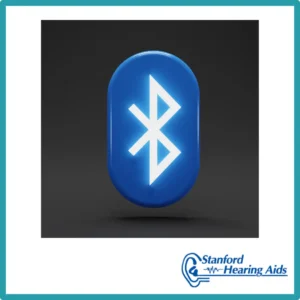Top 10 Things to Know About Bluetooth Hearing Aids
Bluetooth hearing aids offer advanced connectivity, but some wonder: Can Bluetooth hearing aids cause vertigo? Let’s explore the key facts about these devices, their benefits, and potential concerns.
1. Bluetooth Hearing Aids Use Wireless Technology for Seamless Connectivity
Bluetooth hearing aids connect to smartphones, TVs, and other devices, allowing for hands-free communication and direct audio streaming. They use low-energy Bluetooth signals to transmit sound, ensuring a clear listening experience without interference.

Unlike traditional hearing aids, Bluetooth models allow users to adjust volume, switch programs, and control settings via smartphone apps. This flexibility ensures a personalized hearing experience that adapts to different listening environments.
2. Bluetooth Hearing Aids Rarely Cause Vertigo, But Some Users Experience Temporary Dizziness
Most people do not experience dizziness or vertigo with Bluetooth hearing aids. However, some report temporary balance disturbances due to improper fit, sudden exposure to amplified sounds, or pre-existing inner ear conditions.
Benign paroxysmal positional vertigo (BPPV) is a common cause of vertigo, occurring when small calcium particles shift within the inner ear. While Bluetooth hearing aids do not directly cause BPPV, sudden auditory changes may contribute to temporary discomfort. If dizziness persists, consult a hearing care provider.
3. Bluetooth Hearing Aids Improve Speech Clarity and Reduce Background Noise
A major benefit of Bluetooth hearing aids is their ability to enhance speech clarity. These devices stream audio directly into the ears, filtering out background noise and improving communication in noisy settings.
Different hearing aid brands and models take varying approaches to improving speech clarity. Here are some of the best Bluetooth-enabled hearing aids that provide superior speech processing:
- Phonak Audéo Infinio & Lumity – These models use SmartSpeech™ Technology to improve speech understanding, even in noisy environments. They provide universal Bluetooth connectivity, making them versatile for daily use.
- Starkey Genesis AI & Edge AI – Starkey’s hearing aids utilize AI-driven enhancements that automatically adjust settings for clearer speech and background noise reduction. These devices also support health tracking and fall detection.
- ReSound Nexia & Vivia – ReSound models focus on delivering natural sound quality, even in challenging environments. Vivia models have a second chip dedicated to background noise suppression. All Nexia and Vivia models offer direct streaming from iOS and Android devices and provide Auracast™ compatibility for future connectivity enhancements.
- Unitron Moxi Blu & Moxi Vivante – These hearing aids use AI-based speech separation technology, helping users distinguish voices from background noise more effectively. Tap Control features make answering calls and switching programs effortless.
Each of these models enhances speech clarity by leveraging digital signal processing, adaptive microphones, and noise management strategies. By working with a hearing care provider, users can select the right model to meet their specific needs and optimize their communication abilities.
Find out more about the best hearing aids for noisy environments.

4. Hands-Free Functionality Enhances Convenience and Daily Communication
Bluetooth hearing aids allow users to take phone calls without touching their devices. Many models feature automatic audio switching, making it easy to transition between phone calls, music, and surrounding sounds.
Users can also connect to multiple devices simultaneously, switching between a smartphone, tablet, and TV without needing to manually re-pair each time. This feature is particularly useful for multitasking and staying connected in various environments.
5. Battery Life Considerations Are Important for Bluetooth Hearing Aid Users
Bluetooth hearing aids consume more power than traditional models due to continuous connectivity and streaming features. While many models offer rechargeable options, users should monitor battery levels to avoid unexpected shutdowns.
Some hearing aids include quick-charge technology, providing several hours of use with just a short charging period. Understanding battery management and charging routines is essential for consistent performance and uninterrupted listening.
6. Bluetooth Hearing Aids Work With Most Smartphones and Smart Devices
Most Bluetooth hearing aids are compatible with both iOS and Android devices. However, some models require additional accessories for full functionality. Before purchasing, verify that the hearing aids are compatible with your preferred devices.
Manufacturers also provide dedicated mobile apps for enhanced control. These apps allow users to fine-tune sound settings, monitor battery life, and even track hearing aid usage over time.
7. Signal Interference May Occur in Certain Environments
Bluetooth signals can occasionally experience interference from Wi-Fi routers, other electronics, or crowded wireless environments. If connectivity issues arise, adjusting the signal frequency or moving away from interference sources can help.
Newer Bluetooth hearing aids incorporate adaptive frequency technology, reducing the likelihood of signal disruption. Keeping devices updated with the latest firmware also improves performance and reliability.
8. Advanced Customization Offers a Personalized Hearing Experience
Many Bluetooth hearing aids offer extensive customization through mobile apps. Users can adjust volume, switch programs, and fine-tune sound settings based on their specific hearing needs.
Some advanced models feature AI-driven sound processing, automatically adapting to different listening situations. These hearing aids learn user preferences and make real-time adjustments, ensuring an optimal hearing experience.
9. Selecting the Right Bluetooth Hearing Aid Requires Careful Consideration
Not all Bluetooth hearing aids offer the same features. Choosing the right model depends on factors such as hearing loss severity, lifestyle needs, and comfort preferences. Working with a hearing care provider ensures that you receive a customized solution.
When selecting a Bluetooth hearing aid, consider:
- Sound clarity and noise reduction capabilities
- Battery life and charging options
- Compatibility with smartphones and other devices
- Comfort, fit, and design
- Additional features like health tracking and remote adjustments
Understand more about finding the best hearing aid store.

10. The Future of Bluetooth Hearing Aids Will Bring More Innovations
Hearing aid technology continues to evolve, with artificial intelligence and machine learning improving performance. Future models will likely feature enhanced connectivity, longer battery life, and greater personalization.
Manufacturers are also integrating Bluetooth hearing aids with smart home devices, allowing users to receive notifications, control appliances, and access voice assistants directly through their hearing aids. These innovations will enhance user convenience and accessibility.
Take Control of Your Hearing Health
Bluetooth hearing aids offer significant benefits, including improved sound quality, seamless connectivity, and enhanced user control. If you experience dizziness or need assistance finding the right model, contact Stanford Hearing today. Our hearing care providers will help you choose the best hearing solution for your needs.
